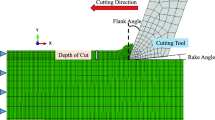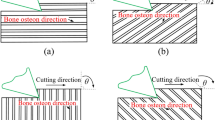Abstract
The research on the crack propagation mechanism of bone has important research significance and clinical medical value for the selection of cutting parameters and the development of new surgical tools. In this paper, an extended finite element method (X-FEM) model of ultrasonic bone cutting considering microstructure was developed to further study the ultrasonic bone cutting mechanism and to quantitatively analyze the effects of cutting direction, ultrasonic parameters, and cutting parameters on the mechanism of ultrasonic bone cutting crack propagation. The results show that ultrasonic bone cutting is essentially a controlled crack propagation process, in which brittle crack and fatigue crack are the main crack propagation mechanisms. In order to improve the efficiency of ultrasonic bone cutting, large amplitude and high-frequency ultrasonic vibration are preferred. Compared with the other two cutting directions, the crack propagation deflection angle in the transverse cutting direction is the largest, resulting in the worst cutting surface. Therefore, in the path planning of orthopedic surgical robots, the transverse cutting direction should be avoided as much as possible. Frequency only has a significant effect on the crack propagation rate and has a positive correlation. There is a positive correlation between the deflection angle, propagation length, propagation rate, and amplitude, which provides the possibility to control the direction and length of crack propagation by controlling the amplitude of ultrasonic. The feed speed is much lower than the ultrasonic vibration speed, which makes the influence of ultrasonic vibration speed on the crack propagation characteristics dominant. The X-FEM model of ultrasonic bone cutting provides an effective method for selecting reasonable machining parameters of orthopedic robot and optimize the design of ultrasonic osteotome.




















Similar content being viewed by others
References
Abdel-Wahab AA, Maligno AR, Silberschmidt VV (2012) Micro-scale modelling of bovine cortical bone fracture: analysis of crack propagation and microstructure using X-FEM. Comput Mater Sci 52:128–135. https://doi.org/10.1016/J.COMMATSCI.2011.01.021
Alam K (2014) Experimental and numerical investigation of cracking behavior of cortical bone in cutting. Technol Health Care 22:741–750. https://doi.org/10.3233/THC-140848
Alam K, Mitrofanov AV, Silberschmidt VV (2009) Finite element analysis of forces of plane cutting of cortical bone. Comput Mater Sci 46:738–743. https://doi.org/10.1016/J.COMMATSCI.2009.04.035
Alam K, Kerckhofs G, Mitrofanov A et al (2012) On-line analysis of cracking in cortical bone under wedge penetration. Proc Inst Mech Eng H 226:709–717. https://doi.org/10.1177/0954411912451824
Bai W, Shu L, Sun R et al (2020) Mechanism of material removal in orthogonal cutting of cortical bone. J Mech Behav Biomed Mater 104:103618. https://doi.org/10.1016/J.JMBBM.2020.103618
Behiri JC, Bonfield W (1980) Crack velocity dependence of longitudinal fracture in bone. J Mater Sci 15:1841–1849. https://doi.org/10.1007/BF00550605
Behiri JC, Bonfield W (1984) Fracture mechanics of bone—The effects of density, specimen thickness and crack velocity on longitudinal fracture. J Biomech 17:25–34. https://doi.org/10.1016/0021-9290(84)90076-9
Budyn É, Hoc T (2007) Multiple scale modeling for cortical bone fracture in tension using X-FEM. Eur J Comput Mech 16:213–236. https://doi.org/10.3166/remn.16.213-236
Budyn E, Hoc T, Jonvaux J (2008) Fracture strength assessment and aging signs detection in human cortical bone using an X-FEM multiple scale approach. Comput Mech 42:579–591. https://doi.org/10.1007/s00466-008-0283-1
Chen Q-S, Dai L, Liu Y, Shi Q-X (2020) A cortical bone milling force model based on orthogonal cutting distribution method. Adv Manuf 8:204–215. https://doi.org/10.1007/s40436-020-00300-7
D.S.S.C. Abaqus (2010)
Fries T-P (2020) Extended finite element methods (XFEM). In: Altenbach H, Öchsner A (eds) Encyclopedia of continuum mechanics. Springer, Berlin Heidelberg, pp 868–877
Gao X, Li S, Adel-Wahab A, Silberschmidt V (2013) Effect of random microstructure on crack propagation in cortical bone tissue under dynamic loading. J Phys Conf Ser 451:012033. https://doi.org/10.1088/1742-6596/451/1/012033
Gustafsson A, Isaksson H (2022) Phase field models of interface failure for bone application—evaluation of open-source implementations. Theoret Appl Fract Mech 121:103432. https://doi.org/10.1016/J.TAFMEC.2022.103432
Gustafsson A, Khayyeri H, Wallin M, Isaksson H (2019a) An interface damage model that captures crack propagation at the microscale in cortical bone using XFEM. J Mech Behav Biomed Mater 90:556–565. https://doi.org/10.1016/J.JMBBM.2018.09.045
Gustafsson A, Wallin M, Isaksson H (2019b) Age-related properties at the microscale affect crack propagation in cortical bone. J Biomech 95:109326. https://doi.org/10.1016/J.JBIOMECH.2019.109326
Jacobs CH, Pope MH, Berry JT, Hoaglund F (1974) A study of the bone machining process—orthogonal cutting. J Biomech 7:131–136. https://doi.org/10.1016/0021-9290(74)90051-7
Khoei AR, Bahai H, Giannakeas IN et al (2023) The eXtended–finite element method (X – FEM) through state of the art applications. Compr Struct Integr. https://doi.org/10.1016/B978-0-12-822944-6.00021-9
Li S, Abdel-Wahab A, Silberschmidt VV (2013) Analysis of fracture processes in cortical bone tissue. Eng Fract Mech 110:448–458. https://doi.org/10.1016/J.ENGFRACMECH.2012.11.020
Li S, Abdel-Wahab A, Demirci E, Silberschmidt V (2014) Fracture process in cortical bone: X-FEM analysis of microstructured models. In: Bigoni D, Carini A, Gei M, Salvadori A (eds) Fracture phenomena in nature and technology. Springer, Cham, pp 43–55
Liao Z, Axinte DA (2016) On chip formation mechanism in orthogonal cutting of bone. Int J Mach Tools Manuf 102:41–55. https://doi.org/10.1016/J.IJMACHTOOLS.2015.12.004
Lucas M, MacBeath A, McCulloch E, Cardoni A (2006) A finite element model for ultrasonic cutting. Ultrasonics 44:e503–e509. https://doi.org/10.1016/J.ULTRAS.2006.05.115
Marco M, Rodríguez-Millán M, Santiuste C et al (2015) A review on recent advances in numerical modelling of bone cutting. J Mech Behav Biomed Mater 44:179–201. https://doi.org/10.1016/J.JMBBM.2014.12.006
MATLAB (2007).
McCulloch E, MacBeath A, Lucas M (2006) A finite element model for ultrasonic cutting of toffee. Appl Mech Mater 5–6:519–526. https://doi.org/10.4028/www.scientific.net/AMM.5-6.519
Nabibekov M, Plyushchenkov B, Sarkisov I (1980) Study of ultrasonic cutting of soft biotissues. Mech Compos Mater 16:377–382. https://doi.org/10.1007/BF00608344
Santiuste C, Rodríguez-Millán M, Giner E, Miguélez H (2014) The influence of anisotropy in numerical modeling of orthogonal cutting of cortical bone. Compos Struct 116:423–431. https://doi.org/10.1016/J.COMPSTRUCT.2014.05.031
Shu L, Sugita N (2020) Analysis of fracture, force, and temperature in orthogonal elliptical vibration-assisted bone cutting. J Mech Behav Biomed Mater 103:103599. https://doi.org/10.1016/J.JMBBM.2019.103599
Shu L, Sugita N, Oshima M, Mitsuishi M (2018) Design and experimental force analysis of a novel elliptical vibration assisted orthopedic oscillating saw. Med Eng Phys 54:22–31. https://doi.org/10.1016/J.MEDENGPHY.2018.02.005
Smith A, Nurse A, Graham G, Lucas M (1996) Ultrasonic cutting—a fracture mechanics model. Ultrasonics 34:197–203. https://doi.org/10.1016/0041-624X(95)00078-H
Sugita N, Mitsuishi M (2009) Specifications for machining the bovine cortical bone in relation to its microstructure. J Biomech 42:2826–2829. https://doi.org/10.1016/J.JBIOMECH.2009.08.017
Sugita N, Osa T, Aoki R, Mitsuishi M (2009) A new cutting method for bone based on its crack propagation characteristics. CIRP Ann 58:113–118. https://doi.org/10.1016/J.CIRP.2009.03.057
Sugita N, Ishii K, Sui J, Terashima M (2014) Multi-grooved cutting tool to reduce cutting force and temperature during bone machining. CIRP Ann 63:101–104. https://doi.org/10.1016/J.CIRP.2014.03.069
Sugita N, Shu L, Shimada T et al (2017) Novel surgical machining via an impact cutting method based on fracture analysis with a discontinuum bone model. CIRP Ann 66:65–68. https://doi.org/10.1016/J.CIRP.2017.04.028
Wang L, Liu Y, Yu Y, He F (2022) Research on reliability of mode coupling chatter of orthopedic surgery robot. Proc Inst Mech Eng C J Mech Eng Sci. https://doi.org/10.1177/09544062221085089
Wang L, Liu Y, Li J et al (2023) Indirect measurement method of ultrasonic bone cutting force based on anti-node vibration displacement. J Sound Vib 552:117637. https://doi.org/10.1016/j.jsv.2023.117637
Yazid A, Abdelkader N, Abdelmadjid H (2009) A state-of-the-art review of the X-FEM for computational fracture mechanics. Appl Math Model 33:4269–4282. https://doi.org/10.1016/J.APM.2009.02.010
Ying Z, Shu L, Sugita N (2020) Experimental and finite element analysis of force and temperature in ultrasonic vibration assisted bone cutting. Ann Biomed Eng 48:1281–1290. https://doi.org/10.1007/s10439-020-02452-w
Zhang Y, Robles-Linares JA, Chen L et al (2022) Advances in machining of hard tissues—from material removal mechanisms to tooling solutions. Int J Mach Tools Manuf 172:103838. https://doi.org/10.1016/J.IJMACHTOOLS.2021.103838
Acknowledgements
This research was supported by the National Natural Science Foundation of China (Grant Nos. 51875094), Natural Science Foundation of Liaoning Province (Grant Nos. 2022-YGJC-15), and Fundamental Research Funds for the Central Universities (Grant Nos. N303027). The commercial transducer was supplied by Guilin Woodpecker Medical Instrument Co., Ltd.
Funding
This research was supported by the National Natural Science Foundation of China (Grant Nos. 51875094), Natural Science Foundation of Liaoning Province (Grant Nos. 2022-YGJC-15), and Fundamental Research Funds for the Central Universities (Grant Nos. N303027).
Author information
Authors and Affiliations
Contributions
LW was involved in conceptualization, methodology, software, validation, formal analysis, investigation, data curation, writing original draft, and visualization. YL was responsible for resources, supervision, and funding acquisition. SW, JL, YS, JW, and QZ contributed to software, investigation, and writing—review and editing.
Corresponding author
Ethics declarations
Competing interests
The authors declare no competing interests.
Conflicts of interest
The authors declare that there is no conflict of interest regarding the content of this article.
Data availability
All data generated or analyzed during this study are included in this published article.
Additional information
Publisher's Note
Springer Nature remains neutral with regard to jurisdictional claims in published maps and institutional affiliations.
Supplementary Information
Below is the link to the electronic supplementary material.
Supplementary file1 (MP4 2770 kb)
Rights and permissions
Springer Nature or its licensor (e.g. a society or other partner) holds exclusive rights to this article under a publishing agreement with the author(s) or other rightsholder(s); author self-archiving of the accepted manuscript version of this article is solely governed by the terms of such publishing agreement and applicable law.
About this article
Cite this article
Wang, L., Liu, Y., Wang, S. et al. Research on ultrasonic bone cutting mechanism based on extended finite element method. Biomech Model Mechanobiol (2024). https://doi.org/10.1007/s10237-023-01810-6
Received:
Accepted:
Published:
DOI: https://doi.org/10.1007/s10237-023-01810-6




